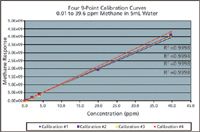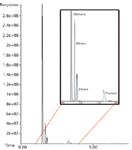Purge-and-Trap GC Analysis of Methane in Water Samples Associated with Hydraulic Fracturing
The Application Notebook
Shale gas reservoirs, such as the Marcellus shale reserve in Pennsylvania and Barnett shale reserve in Texas are a growing source of natural gas in the United States. Hydraulic fracturing or "fracking" involves pumping water, sand, and chemicals at extremely high pressure into deep underground wells to crack open hydrocarbon-rich shale formations and extract natural gas.
Shale gas reservoirs, such as the Marcellus shale reserve in Pennsylvania and Barnett shale reserve in Texas are a growing source of natural gas in the United States. Hydraulic fracturing or "fracking" involves pumping water, sand, and chemicals at extremely high pressure into deep underground wells to crack open hydrocarbon-rich shale formations and extract natural gas. Chemicals used for hydraulic fracturing include potentially toxic substances such as diesel fuel and disinfectants which can contaminate underground sources of drinking water (USDW). In some cases methane has been detected in household drinking water from wells (1).
This application note describes the use of a purge-and-trap gas chromatography system to analyze methane, ethane, ethene, and propane hydrocarbons (C1-C3) in drinking water samples.
Experimental Conditions
Instrumentation used for this study was an OI Analytical Eclipse 4660 Purge-and-Trap sample concentrator with a proprietary trap specifically designed to trap methane. The P&T was interfaced to an Agilent 7890 GC-FID with a split/splitless injector and a SUPEL-QPLOT column (30-meter × 0.32-mm i.d.).
Results
Four unique nine-point calibration curves (0.01 to 39.6 ppm) were prepared and analyzed on the optimized system. Methane peak area counts were plotted as a function of concentration to generate an external calibration curve for each set of analyses. The four resulting curves are plotted together in Figure 1, along with their linear correlation coefficients (R2 ) and illustrate the overall reliability and stability of the analytical system.

Figure 1: Nine-point calibration curves of methane in water with linear correlation coefficients.
Figure 2 is the FID chromatogram from analysis of a 5-mL water sample saturated with methane (~40 ppm) and containing single-digit ppm levels of ethane, ethene, and propane. Baseline resolution was obtained for all four peaks.

Figure 2: FID chromatogram of methane saturated sample (~40 ppm) with single-digit ppm levels of ethane, ethene, and propane.
For complete results of this study, refer to OI Analytical Application Note # 3792 (2).
Conclusions
The results of this study demonstrate that purge-and-trap GC analysis can be used to measure methane contamination in water samples. The system yielded linear calibrations and complete baseline separation of methane, ethane, ethene, and propane.
References
(1) S.G. Osborn, A. Vengosh, N.R. Warner, and R.B. Jackson, "Methane contamination of drinking water accompanying gas-well drilling and hydraulic fracturing," Proceedings of the National Academy of Sciences, 109(20), 8172–8176 (2011).
(2) OI Analytical Application Note # 3792, "Purge-and-Trap GC Analysis of Methane in Water Samples Associated with Hydraulic Fracturing".
OI Analytical
P.O. Box 9010, College Station, TX 77842
Tel. (800) 653-1711, or (979) 690-1711, fax (979) 690-0440
Email: oimail@oico.com, Website: www.oico.com

Separation of Ultra-Short and Long Chain PFAS Compounds Using a Positive Charge Surface Column
December 11th 2024A separation of ultra-short and long chain PFAS (C1-C18) is performed on a HALO®PCS Phenyl-Hexyl column along with a HALO®PFAS Delay column which demonstrates excellent retention for both hydrophilic and hydrophobic analytes.















